III. ANALYSIS OF FEEDING SIGNALS
A. GENERATION OF FEEDING SIGNALS
During the signal collection process, it can be observed through real-time photographic recording that before the first feeding, most of the shrimp were not moving at the bottom of the tank, and some of them were swimming. 30 seconds after the signal collection, the required feed was put into the tank, and most of the shrimp began to swim and grab food. With the increase of collection time, most of the shrimp gradually stopped swimming and ate at the bottom of the tank. Before the second feeding, the situation in the tank was the same as that in the first feeding signal collection. After feeding, only a small number of shrimp were moving to grab food. Until the third feeding signal collection, almost no shrimp was moving after feeding.
Through the time-domain observation of the three collected signals, before feeding in the experimental tank of 5 shrimp, almost no signal was generated and then be collected. After 30 seconds, signals are detected and collected, as shown in Fig. 4(a), (b), and (c). After 30 seconds of signal acquisition, the food was fed. By comparing with the photographic record, the shrimp began to move to grab food and eat, and the acoustic signal generated during the movement of the shrimp was collected. As the number of feedings increased, most of the shrimp stopped moving to grab the food. This phenomenon indicates that the movement of shrimp to grab food represents the feeding activity. When the shrimp was fed for the first time, the degree of starvation was high, and the number of collected signals was dense and large. Signals were generated during the entire collection time, indicating the progress of the feeding activities. With the increase of feeding times, the starvation degree of shrimp decreased. They gradually stopped moving, and the number of acoustic signals collected decreased. Until the end of the third feeding signal collection period, no signal was collected. The three feeding signals collected in the 10-shrimp experiment tank are roughly the same as those in the 5-shrimp experiment tank, as shown in Fig. 4(d), (e), and (f).
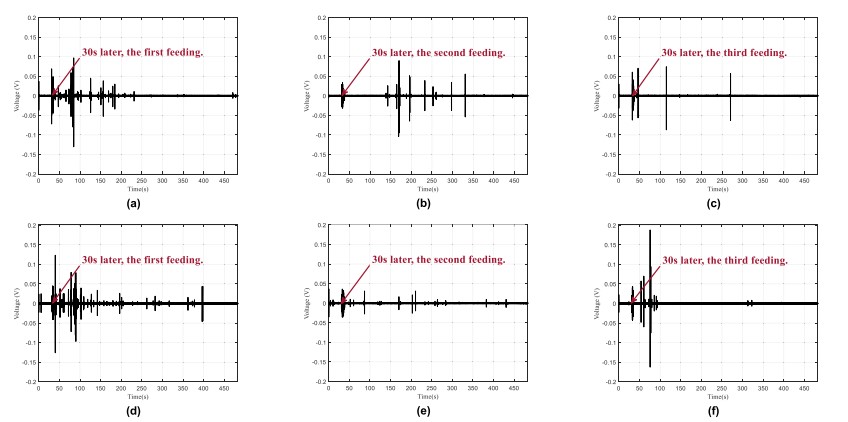
FIGURE 4. Time domain of signal acquisition for 3 different feedings. (a, b, c) 5-shrimp, (d, e, f) 10-shrimp.
The signal is analyzed by short-time Fourier transform, and the window length is 0.1s. In the case of different numbers of shrimp, 30 seconds after the first feeding, the energy of 15-25dB in the frequency range of 2-10KHz increased significantly, and it lasted for 10 seconds after the feeding started, as shown in the red box of Fig. 5. In the latter period of time, energy intermittently increased significantly, indicating the progress of feeding activities of shrimp.
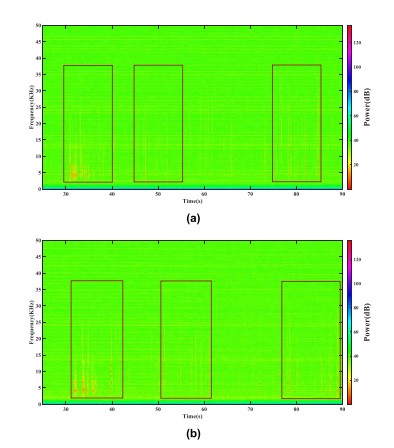
FIGURE 5. Time-frequency distribution of signal collected for the first feeding. (a) 5-shrimp, (b) 10-shrimp.
B. ANALYSIS OF TIME DOMAIN WAVEFORM AND FREQUENCY SPECTRUM OF FEEDING SIGNALS
The feeding acoustic signal generated by the movement of Litopenaeus vannamei collected in the experiment is in the form of a single pulse, as indicated by magnified graph in red box in Fig. 6. The signal duration range is 8-10ms, and the frequency range is 2-10 KHz. There is a maximum spectral peak near the frequency of 5KHz, and the intensity is about – 78dB, as shown in Fig. 7(a). Comparing the frequency domain waveform of the shrimp feeding interval with the frequency

FIGURE 6. Feeding signals.
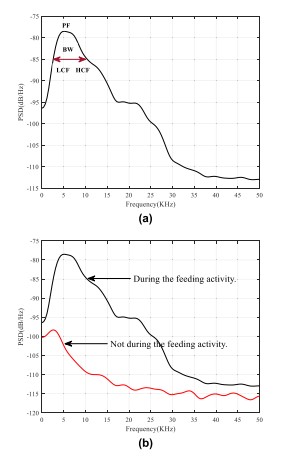
FIGURE 7. Frequency domain waveform of shrimp feeding signals.
domain waveform of the shrimp not feeding interval, it can be found that in the range of 2-10KHz, the signal energy of the former is higher than that of the latter, indicating that new acoustic signals is generated during feeding, as shown in the Fig. 7(b).
Compared with the Penaeus monodon (giant tiger prawn) feeding sound signal studied by Daniel et al. [3], most of the signal energy of the tiger prawn feeding sound signal is concentrated in the resonance frequency band between 3KHz and 7.6KHz on average, the signal duration is between 0.48ms and 0.72ms, and the maximum peak appears in the range of 5-10KHZ.
C. CORRELATION BETWEEN FEEDING SOUND SIGNALS AND SWIMMING MOVEMENT
Litopenaeus vannamei is in a state of restlessness during hypoxia, and most of the shrimp are swimming quickly in the tank. The experiment carried out 1-minute data signal acquisition for this situation, as shown in Fig. 8. Correlation calculation is carried out between the shrimp feeding signal d(t) and the complete shrimp hypoxic agitation signals(t) [6], so as to obtain the detected value, which represents the correlation value D at each time step t.

 FIGURE 8. Motion signals of shrimp in hypoxic state-time domain.
FIGURE 8. Motion signals of shrimp in hypoxic state-time domain.
Through the correlation detection algorithm, the correlation value is higher than 0.05, indicating that the correlation between the signals is high, as shown by the red line in Fig. 9. This result also shows that shrimp move intensively when they are hungry, and then grab food and produce motion sound signals, which characterize the progress of feeding activities

FIGURE 9. Correlation between motion signals of shrimp in hypoxic state and single feeding signal.
IV. DETECTION OF THE EFFECTIVE RANGE OF THE FEEDING SIGNALS
Before the detection of the effective range of the feeding signal, the measured initial signal is preprocessed, and a band-pass filter is applied to the signal, thereby suppressing the influence of environmental, man-made or biological noise on the target signal. Next, through threshold detection, the starting point and ending point of the signal are detected. Because in the next shrimp feeding signal processing, only the signal segment is processed. In this study, the dual-threshold method was used to detect the effective range of feeding signal. The algorithm is based on the short-term energy and the short-term average zerocrossing rate of the signal [12]. The effective shrimp feeding signal is determined by a two-level threshold judgment method. In the actual operation of the detection, after the normalization process, the collected signal is first processed by window division, with the window length of 0.01s. On the basis of the window division, the short-term average energy and short-time average zero crossing rate of the signal are obtained, and the comparison and judgment are made according to the threshold value.
Suppose the time domain of the collected signal is s(n), and the i-th window signal obtained after windowing by the window function w(n) is yi(n), then yi(n) satisfies:

In the equation, w(n) is the Hamming window; yi(n) is the voltage amplitude collected by the i-th window signal, L is the window length; inc is the window shift length; fn is the total number of windows after the signal is windowed.
The short-term energy equation for calculating the i-th window signal is

The short-term average zero-crossing rate indicates the number of times the signal waveform crosses the zero level in a window signal. For continuous signals, zero crossing means that the time-domain waveform passes through the time axis; for discrete signals, if adjacent sample values change signs, it is called zero crossing. The short-term average zero-crossing rate is the number of times the sample value changes sign
The short-term average zero-crossing rate equation for calculating the i-th window signal is:

After calculating the short-term energy and the short-term average zero-crossing rate of the complete signal, the first decision is made. First, according to the short-term energy of the signal, a higher threshold H1 is selected for rough judgment. There are starting and ending points of the feeding signal in the range outside the time point corresponding to the intersection of this threshold and the short-term energy envelope. Then select a lower threshold H2, continue to search from the possible range of the last rough judgment, and find the two points A and B where the threshold H2 intersects the short-term energy envelope. These two points are the starting point and the ending point of the feeding signal determined by the short-term energy. After that, a secondary judgment is made on the basis of the first judgment. At this time, based on the short-term average zero-crossing rate, select the threshold H3, and continue searching from outside the range determined by points A and B, and find two points C and D where the threshold and the short-term average zero-crossing rate intersect respectively. Finally, the range between the time points corresponding to points C and D is the effective range of the shrimp feeding signal.

FIGURE 10. Detection of the effective range of the feeding signals (5-shrimp). (a, d) The first feeding, (b, e) The second feeding, (c, f) The third feeding.
Fig. 10(a), (b), and (c) show the detection results of the effective range of the signals collected by three feedings in the 5-shrimp experimental tank. The red box is the detected signal. The partial enlarged view is shown in Fig. 10(d), (e), and (f). The red solid line is the starting point of the feeding signal, and the red dashed line is the ending point of the feeding signal. According to the figure, the number of signals detected during the first feeding is higher than the last two feedings. The motion sound signal produced by the shrimp during feeding will gradually decrease as the decrease of shrimp starvation and the increase of feeding times. The detection results of three feeding signals collected in the experimental tank where 10-shrimp are located are roughly the same as those in the experimental tank for 5-shrimp, as shown in Fig. 11.
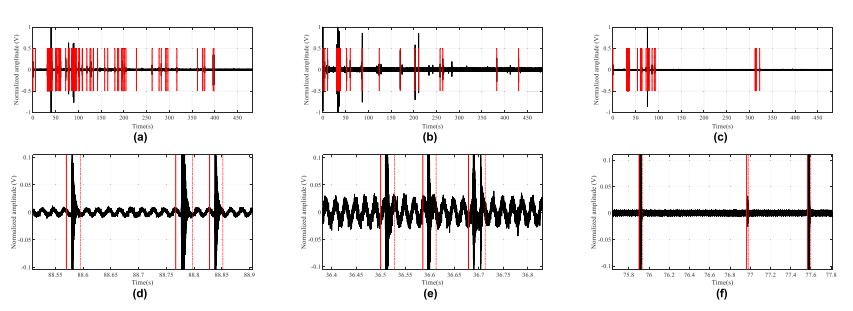
FIGURE 11. Detection of the effective range of the feeding signals (10-shrimp). (a, d) The first feeding, (b, e) The second feeding, (c, f) The third feeding.
According to the number of signals generated by different shrimp numbers and feeding times, as shown in Fig. 12. During the first feeding, the number of sound signals generated by 10 shrimp within 8 minutes of data collection could reach 88, and in the same experimental scenario, the number of acoustic signals of 5 shrimp could reach 47. More than half of the signals were detected within 1 minute after feeding. With the increase of time, the number of signal detection gradually decreased. In the later stage of collection, almost no signal was detected. That is, with the increase of feeding times, the starvation degree of shrimp decreased, and the movement gradually stopped, and the number of acoustic signals collected decreased. At the same time, in the experimental tank of 10 shrimp, the number of shrimp feeding signals collected by three feedings was higher than that of 5 shrimp experimental tank. This phenomenon indicates that the number and the starvation degree of shrimp are directly proportional to the number of shrimp feeding signals. As the number of feeding times increases, the starvation degree of shrimp and the number of shrimp feeding signals decreases.

FIGURE 12. Statistics on the number of shrimp feeding signals.
V. NOISE SIGNAL ANALYSIS
When the oxygen generator is not turned off, the continuous background noise generated by the oxygen generator will affect the signal acquisition. In future detection algorithms, the key problem is how to detect shrimp feeding signals from the continuous background noise generated by the oxygen generator. The signal generated by the oxygen generator is similar to the shrimp feeding sound signal, and in the time domain, it is also a repetitive single pulse signal, as shown in Fig. 13.
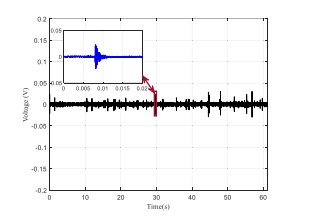
FIGURE 13. Time domain of oxygen generator noise.
When the signal is collected, it is superimposed on the feeding signal as a series of pulse signals. In the frequency domain, the frequency range of the noise signal is 7-13KHz. On average, the resonance band is higher than the feeding signal, and there is a partial overlap of frequency bands, as shown in Fig. 14.

FIGURE 14. Frequency domain comparison of noise signal of oxygen generator and shrimp feeding signal.
In other experimental environments, there are other pulse interferences, coupled with the time similarity of feeding and interference events, which leads to misjudgments in signal detection, which illustrates the potential difficulty in distinguishing feeding activities from other types of pulse interference.
VI. CONCLUSION
Through the comparison of signal time domain analysis and real-time photographic records, in the case of different numbers of shrimp, no acoustic signals were collected when they were not fed, and after 30 seconds of signal acquisition, the food was fed, acoustic signals were collected. When the shrimp was first fed, the starvation level of the shrimp was high. The shrimp grabbed food and ate by swimming. As the number of feedings increased, the starvation of the shrimp decreased, and the intensity of exercise showed a downward trend. The shrimp gradually stopped exercising and then stopped eating. This phenomenon indicates that the start of shrimp feeding will generate the related signals and it is related to shrimp movement. By correlating the collected signal with the acoustic signal of the shrimp moving during hypoxia, the correlation value is high, which further shows that when the shrimp is hungry, it swims and grabs food to generate acoustic signals.
Based on the passive acoustic technology to collect the feeding motion sound signal of Litopenaeus vannamei, through time domain and frequency domain analysis, it is found that the signal is similar to single pulse signal, the duration is about 8-10ms, and the resonance band range in the frequency domain is 2-10KHz. The detection of the effective range of the shrimp feeding signal is carried out by the dualthreshold method, and then the number of shrimp feeding signals is calculated. Through statistical analysis, the number of signals generated during the first feeding of the 10-shrimp experimental tank is the largest. With the decrease of the number of shrimp, the increase of feeding times and the decrease of shrimp hunger degree, the number of feeding signals generated gradually decreases, which provided theoretical basis for further on-demand control of feeding amount.
At the same time, other impulse noises will have a greater impact on the collection and detection of shrimp feeding signals. The noise pulse signal generated by the oxygen generator partially overlaps the resonance frequency band of the target feeding signal. In the future research work, we will consider how to correctly detect the target feeding signal under the background noise generated by the oxygen generator, so as to realize the automatic and intelligent feeding of shrimp and improve economic benefits.
Group of authors: Maochun Wei, Yating Lin, Keyu Chen, Wei Su, (Member, Ieee), và En Cheng
Reference: https://ieeexplore.ieee.org/stamp/stamp.jsp?arnumber=9178285
“Domesticated Shrimp Postlarvae – The Key To Success”
See more:
- Microalgae Boosts Water Quality And Finishing Yield In Whiteleg Shrimp
- Will Future Aquafeeds Turn To Insects Or Single-Cell Proteins?
- Differing Water Salinities Can Shift Bacterial Composition In Ras Shrimp Production


 Tiếng Việt
Tiếng Việt 中文 (中国)
中文 (中国)